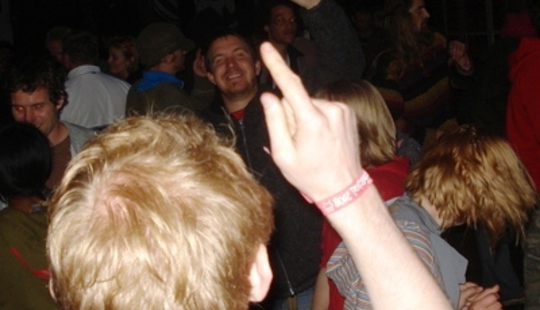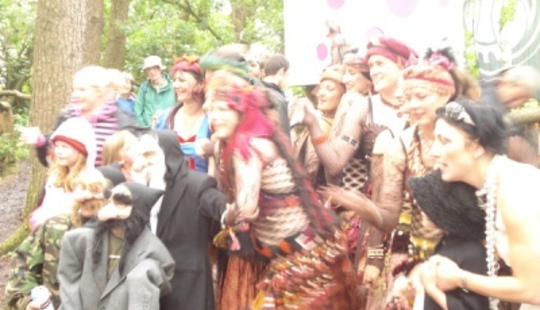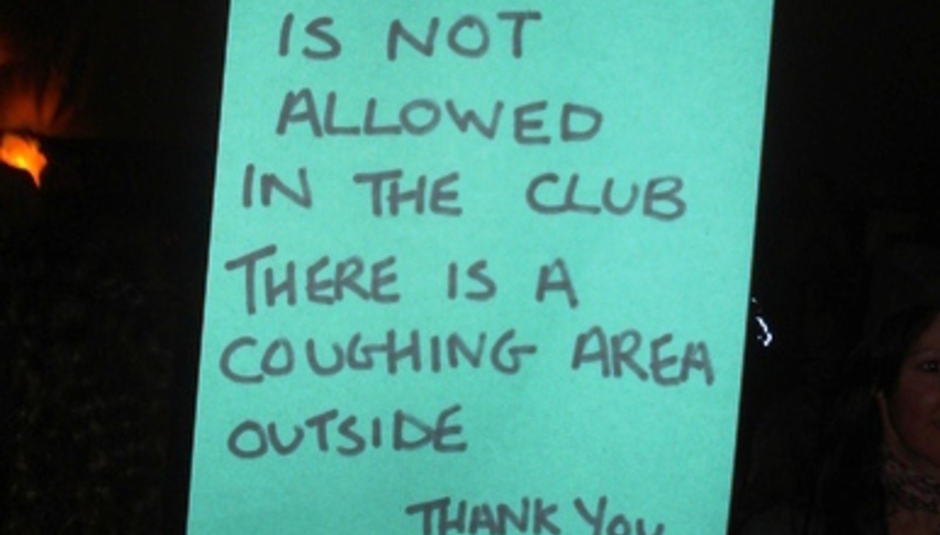The third edition of the annual Beat Herder festival takes places on the Dockber Farm near Sawley, a fairly isolated place in the Ribble Valley in the northern Pennines. As we arrive here late on the Friday night, the festival is already in full swing, with around 4,500 revellers in the fields, surrounded on all sides by high hills and the most dramatic skies you can imagine.
There are several tents and stages at the festival, including a sizable, open-air main stage which attracts the larger acts but, as it is already well into night time, we head straight for the Toil Soundsystem, a dance, well, area, located within the centre of large copse of pine trees.
Above us, there’s a deep red sky which beats any laser and light show you’ve ever seen, though the rest of the set up is straight out of a superclub. There is a genuinely massive soundsystem, a large DJ booth and plenty of room to dance upon the leaves and admire the drama and silliness of a rave in a forest. The numerous DJs don’t spare the beats either, with Toni Jarvis and Utah Saints being in particular class, and the tracks are a good mix of crowd pleasers and cutting-edge stuff.
Beer sales end early, but at this point the situation feeds upon itself. A man in a cloak dances on a tree stump, herds of cow/human hybrids run through the forest, and with all normal boundaries and conventions removed, people are happy to be themselves or something else entirely. The party is hard, but there is a general light and fun atmosphere in the air. Nothing is better though than the simple fact that you are dancing underneath the sky, watching it change from one shade to another ‘til it slowly turns to dawn. Finally leaving the forest in the morning as the fire starts to die, there’s a sunrise coming over the horizon, bringing to mind the experiences some of the earliest ravers must have felt.
With a few hours of sleep gained, it is now time to explore this well-formed festival in further detail. This mission is only hampered by the truly schizophrenic weather, which your nature-numbskull reporter may think is something to do with how high up we are in the hills. Driving rain is followed ten minutes later by blistering sunshine, and the dramatically deep blue or ominous, doom-laden black clouds that bring this can both be seen constantly approaching from the distance, one after the other, which at least allows time for running between tents.
At some point we give up trying to second-guess the weather and head to the main stage. This is a good thing as we catch what we reckon is undoubtedly the best act of the festival. Laboratory Noise are strong and tight players. Their mixture of sounds is expansive but edgy and quite beautiful on all levels. Alternately fuzzy and jangly, they are a well-rounded band that we’ll watch out for in the future.
On our first entry into the tent known as the Beat Herder and District Working Men’s Social Club, we’re treated to a bald club singer, Dewsbury’s finest apparently, and not only can the man sing, but he looks good in that monkey suit. We sample excellent versions of ‘Sway’ and a few Sinatra numbers and leave just as a beefy photographer in a nurse’s suit really starts to get his groove on. Outside on the main stage we have Guessmen. Fronted by a man wearing a pork pie hat and holding a megaphone, they make noises something like Tom Waits crossed with Modest Mouse, though not nearly as good as that sounds on paper.
Perhaps the best part of this festival, if not all festivals, is just chilling on the grass and watching the punters go by. Beat Herder is not short of its fancy dress enthusiasts, with the best we’ve seen probably being the man dressed in a huge costume that looks something like a cross between a Mexican, a fish and an owl. After a while, the line between men and women, human and animal, begins to blur.
One of the highlights of Saturday is a great, long set by the Lancashire Hot Pots. For those of you who live under a rock, or don’t have the benefit of BBC North West Tonight, the Lancashire Hot Pots (MySpace) wear traditional Lancashire working class dress, and do traditional Lancashire working-class folk music. Well, something of an updated version thereof. With songs like ‘He’s Turned Emo’, ‘Chippy Tea’, and ‘Shopmobility Scooter’, it may be one joke, but it is a funny one, at least to most people born north of Watford who don’t have a rod shoved up their arse. They play all the standards and mid-set we get the romantic moment of the festival as a man dressed a woman proposes to a woman dressed as a woman.

- - -
We head back to the Working Men’s Club where a man in his mid ‘30s is doing ‘70s-style bluesy keyboard wig-outs. As he does his thing, we think about how this festival really has come out of the local community, like the clubs that this tent is named in mocking honour of, as a way of coming together to celebrate and have fun. The growing phenomenon of local festivals organised by local people out of the desire to put on a good show for their peers, rather than any desire make cash, seems to tap into something ancient, reaching back almost to carnivals and shows organised by ancient guilds. Perhaps that’s reading too much into things, but looking back at the sort of festivals beloved by the pagans, aside from the electronics, Beat Herder doesn’t seem too far removed.
Walking around the fields, there isn’t a Carling, 02 or even Oxfam logo to be seen, and there’s only a light security presence. But there’s also is the biggest mix of people we’ve ever seen at a festival and amongst the most jovial of atmospheres. You get the impression that any knob-headedness would be stamped out immediately by the punters without the smiling guards having to dive in. There’s also easily the least amount of litter, as people seem to make a real effort to pick up their shit. Maybe that’s down to our increasing environmental concerns, but I reckon, like with the lack of kick-offs, it’s more down to respect. There’s no corporate hand behind this event, however benevolent, and it shows in people’s behaviour. Punters know that lot of people have put a lot of work into the festival so they can have a good time, and it’s paid back in kind.
The festival also manages to pull of the hard trick of being family friendly without being sterile. There are tents where kids can make art and music, and most wander about quite happily with even the hardest ravers checking their behaviour a little in their presence. That said, with some of the early experiences of these kids being so intense as this, you get the impression that by the time some of them have reached the rebellious teenage stage they’ll go straight into injecting coke into their eyeballs.
Beat Herder is also the most heart-on-sleeve northern festival we’ve been too. Not ‘poor us’ or even ‘fuck you’ northern, but: ‘Yeah, we’re northern, crazy, proud, and we know how to have a good time. And we know how to dress as a woman and still look hard as fuck. Beat that.’ As some local rock kids Metallica it up on their day in the sun, a trackied-up scall leads some crusties and hippy mums in a merry jig and we decide to move on.
After another wandering between the stages and tents we realise that we’ve just been in what is likely going to be one of the few situations in life when you’re faced with an entertainment choice within just a few feet of a large brass band, a row of girls doing the can-can, some old men in cowboy hats playing Van Morrison covers, and a tent-load of serious drum and bass.

- - -
Saturday night sees X Press 2 on the main stage, which generates some pure old-school rave action amongst the crowd, but it’s in the trees that it’s really kicking off. We arrive to a great set from Andrew Weatherall, the man behind Primal Scream’s ‘Loaded’ and perhaps the most famous act on at the festival. It’s a stellar set and afterwards Mr Weatherall stands at the side of the stage beaming like a Cheshire Cat at the situation as Domski takes over DJ duties. At this point we stumble across a tunnel, the size of a ventilation shaft, which, after some complex negotiation, we find leads us into a well populated living room. There’s nothing on the telly, so we head back to the rave.
On Sunday morning, after trying to second-guess the whether for too long, we head back into the trees and get some really class hard house from a DJ called Nick, of ‘Nick and Gaz’ apparently, and despite having an inch of mud rather than a sprung dance floor, pull-off some decent afternoon moves. We’re watched curiously by some nearby children and we try to work out whether we’re being a good example or a gentle warning.
Back on the main stage, we learn to avoid Daniel Orlick and the Diplomats in the future. Mr Orlick is cretinous Yank with crap lyrics to crap songs, made much worse by his continually whiny-voiced bluster about how he doesn't care what we think. Despite this posturing, you still get the impression that after the set he’s going to go home and bang his head repeatedly against the mirror ‘til he passes out.
At this point we decide that we’re not muddy enough not to care anymore, but too muddy to be comfortable; time for a swift exit.
It seems as if 2008 is the year that Glastonbury lost its shine amongst the underground. The festival, famous all over the world, now gets just too much mainstream media coverage and too many nice middle-class people attending it. Possibly a load of rubbish, but that’s the consensus.
It was the inception of that festival in 1970 though, that seemed to re-awaken something deep in the British consciousness; a need for a collective celebration, silliness and the breaking of the ever-increasing drudgery of everyday existence. Since then Glastonbury, along with the legacy of the illegal rave scene, has helped make Britain the festival capital of Europe and spawned a hundred other events around the country. Beat Herder is one of these, organised locally, being as much about the visitors as the bands, non-corporate, inclusive and above all a good laugh. It’s a worthy northern successor to Glastonbury and we’ll gladly look forward to another year of sheep and beats.
Find the official Beat Herder website here

















